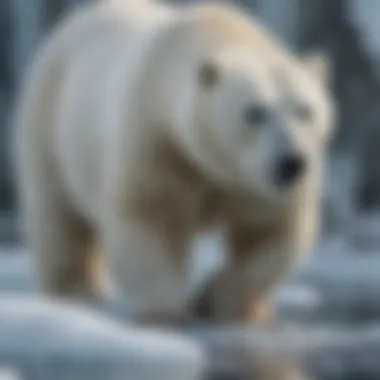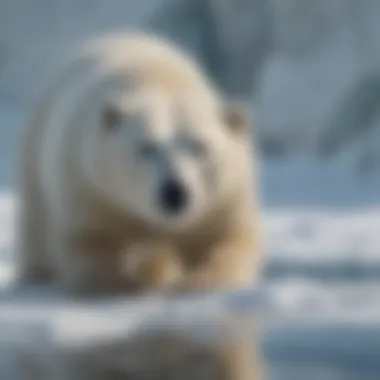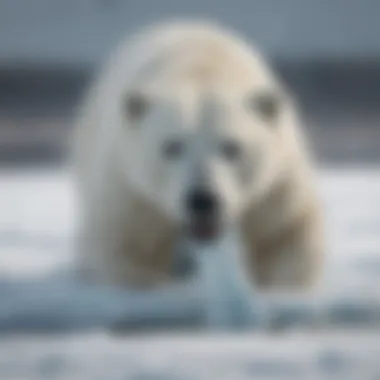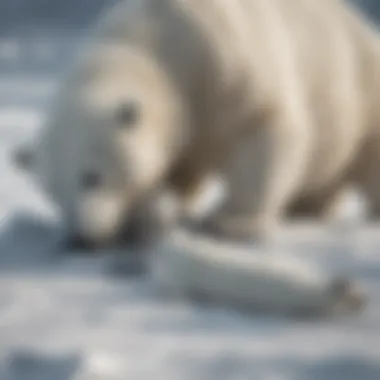Unveiling the Astonishing World of Polar Bear Hunting Seals


Nature Topic Overview
Fun Facts and Trivia
Did you know that a polar bear's fur isn't white but actually transparent? Each hair shaft is filled with air, giving these bears their iconic snowy appearance. Another fascinating fact is that polar bears have an extraordinary sense of smell, capable of detecting a seal several kilometers away, even beneath layers of ice. These remarkable predators also rely on stealth and patience when hunting, often lying camouflaged near seal breathing holes for hours before ambushing their unsuspecting prey.
Wildlife Explorations
In the world of polar bear hunting, understanding the intricate ecosystem of the Arctic is crucial. Seals, such as the ringed seal and bearded seal, play a vital role as a food source for polar bears. Additionally, exploring the flora of the Arctic, like Arctic moss and lichen, allows us to appreciate the unique adaptations of plant life in this harsh environment. Dive deeper into this icy world through interactive quizzes that challenge your knowledge of Arctic wildlife and habitats.
Environmental Awareness
As we marvel at the hunting prowess of polar bears, we must also ponder the importance of conservation efforts to protect these magnificent creatures and their habitat. Climate change poses a significant threat to polar bear populations, as melting sea ice reduces their hunting grounds. By educating children about environmental conservation and sustainability, we empower the next generation to take action and advocate for the preservation of Arctic ecosystems.
DIY Nature Activities
Looking to bring the wonders of polar bear hunting into your home? Engage in hands-on activities such as creating a mini Arctic diorama, complete with polar bears and seals. Follow step-by-step guides to craft nature-inspired artworks using materials found in your surroundings. Encourage outdoor explorations that emulate the hunting strategies of polar bears, fostering a deeper connection with nature and instilling a sense of respect for the delicate balance of life in the Arctic.
Understanding Polar Bears


Understanding polar bears is a crucial aspect of this article as it sheds light on the apex predators of the Arctic. Polar bears, the largest land predators on Earth, have fascinating adaptations that enable them to thrive in their icy habitat. Their physical characteristics, such as a thick layer of blubber and water-repellent fur, play a vital role in their survival. Additionally, exploring the behavioral traits of polar bears offers valuable insights into how they hunt seals with unparalleled stealth and patience, making them successful apex predators.
Polar Bear Habitat
Arctic Regions
The Arctic regions stand out as the primary habitat for polar bears, signifying the harsh yet essential environment where these magnificent creatures reside. With vast expanses of frozen tundra and icy waters, the Arctic provides the ideal setting for polar bears to roam and hunt. The extreme cold temperatures and minimal human intervention allow polar bears to maintain their status as top predators without significant disruptions. However, the melting ice due to climate change poses a severe threat to these bears' traditional hunting grounds, making their habitat increasingly precarious.
Sea Ice Environment
The sea ice environment is another critical component of polar bear habitat, influencing their hunting behavior and survival strategies. Polar bears rely on sea ice as a platform for hunting seals, their primary prey. The sea ice acts as a camouflage for polar bears, enabling them to approach seals stealthily. However, the unpredictable nature of sea ice due to shifting climate patterns presents challenges for polar bears, affecting their ability to hunt and feed efficiently.
Polar Bear Characteristics
Physical Attributes
The physical attributes of polar bears play a significant role in their hunting prowess and survival in the Arctic wilderness. Their immense size, sharp claws, and powerful jaws make them formidable predators, capable of taking down seals with precision and strength. The white fur of polar bears serves as excellent camouflage in the snowy landscape, allowing them to stalk seals effectively. Despite their massive build, polar bears are excellent swimmers, traversing long distances in search of prey.
Behavioral Traits


Polar bears exhibit remarkable behavioral traits that contribute to their success as apex predators. Their patience and stealth during hunting expeditions exemplify their cunning nature and strategic approach. Polar bears can wait for hours by seal breathing holes, anticipating the perfect moment to ambush their unsuspecting prey. Additionally, their ability to swim long distances underwater showcases their adaptability and agility in navigating the icy Arctic waters, reinforcing their status as masterful hunters.
Seal Prey Selection by Polar Bears
Seal prey selection by polar bears is a critical aspect within the broader context of their hunting practices. The choice of seals as prey by polar bears is driven by several factors. Seal blubber, containing high energy reserves, provides essential nutrition for polar bears to survive in the harsh Arctic environment. This section delves into the intricate process through which polar bears select their prey, shedding light on the strategic decision-making involved in their hunting practices. Understanding the nuances of seal prey selection by polar bears is fundamental to appreciating their role as apex predators in the Arctic ecosystem.
Ringed Seals
Ringed seals play a significant role in the diet of polar bears, with their abundance in Arctic regions making them a primary target for these predators. The key characteristic of ringed seals lies in their ability to create breathing holes in sea ice, which polar bears utilize for hunting. This unique feature of ringed seals not only makes them a suitable prey choice for polar bears but also poses challenges due to their elusive nature underwater. Exploring the dynamics of hunting ringed seals provides insights into the adaptive strategies employed by polar bears to secure their sustenance in a competitive environment.
Bearded Seals
In addition to ringed seals, bearded seals represent another prey preference for polar bears. Bearded seals offer a larger prey size compared to ringed seals, providing a substantial food source for polar bears. The key characteristic of bearded seals includes their ability to inhabit varying ice conditions, making them accessible targets for polar bears prowling the Arctic ice. However, the unique feature of bearded seals, their cautious nature when approaching breathing holes, requires polar bears to exhibit patience and skill during hunting. Evaluating the hunting dynamics related to bearded seals unveils the complexities of polar bear predation strategies in diverse Arctic habitats.
Hunting Strategies
The hunting strategies employed by polar bears are tailored to maximize efficiency in capturing seals for sustenance. Still-hunting is a strategic approach where polar bears patiently wait near seal breathing holes, leveraging the element of surprise to secure their prey. This tactic highlights the predator's ability to adapt to the seal's behavior, emphasizing the importance of strategic positioning and timing. Furthermore, the use of patience and stealth underscores the meticulous nature of polar bear hunting, showcasing the predator's adeptness at concealing its presence while waiting for the opportune moment to strike. By exploring these hunting strategies in-depth, a comprehensive understanding of polar bear predatory behavior emerges, emphasizing the intricate balance between adaptation and skill in the Arctic hunting grounds.
Polar Bear Predatory Techniques


Polar Bear Predatory Techniques play a crucial role in understanding the behavior of these apex predators. The ability of polar bears to employ various techniques while hunting seals showcases their adaptability and prowess in their natural habitat. By exploring the specific elements of Polar Bear Predatory Techniques, one can grasp the intricate details of how these bears secure their primary food source. Understanding these techniques provides insights into the evolutionary strategies that have enabled polar bears to thrive in the harsh Arctic environment.
Ambush Tactics
Waiting by Seal Breathing Holes
Waiting by Seal Breathing Holes is a strategic approach employed by polar bears in hunting seals. This method involves patiently observing known seal breathing holes, keeping still and poised for the opportune moment to strike. The key characteristic of Waiting by Seal Breathing Holes lies in the bear's ability to exhibit remarkable patience and stealth while awaiting the arrival of unsuspecting seals. This technique is a popular choice for polar bears due to its effectiveness in maximizing the chances of a successful hunt. The unique feature of Waiting by Seal Breathing Holes is its reliance on the bear's keen sense of smell and sharp instincts to anticipate seal movements. While advantageous in increasing hunting success rates, this technique can also demand unwavering focus and prolonged waiting periods, posing challenges amidst the Arctic's unpredictable conditions.
Swimming Skills
Swimming Skills, particularly Underwater Prowess, significantly contribute to the overall hunting success of polar bears. The ability of polar bears to navigate underwater with exceptional skill enhances their efficiency in hunting seals. Underwater Prowess is characterized by the bear's proficiency in submerging for extended periods and moving swiftly to close in on seals. This skill is a valuable asset for polar bears in catching seals by surprise and utilizing the element of surprise to secure their prey. The unique feature of Underwater Prowess is its seamless integration of strength and agility, allowing polar bears to adapt to the challenges of aquatic hunting with precision. While advantageous in enabling effective underwater hunting, mastering Swimming Skills requires dedication and practice to maintain peak performance levels in hunting pursuits within the Arctic's frigid waters.
Impact of Climate Change
In this segment, we delve into the profound impact of climate change on polar bears, underscoring the critical role it plays in their hunting dynamics and overall survival. Climate change serves as a formidable disruptor to the delicate balance of the Arctic ecosystem, altering the availability and distribution of sea ice – a pivotal factor in polar bear behavior. The reduction in sea ice extent poses a significant challenge for polar bears in accessing their primary hunting grounds, forcing them to travel longer distances in search of elusive seals. Such environmental shifts demand extraordinary adaptability from these apex predators, as they navigate increasingly unpredictable terrain.
Melting Ice and Polar Bears
Challenges for Hunting
The relentless melting of ice presents polar bears with formidable challenges for their hunting expeditions. In the realm of challenges for hunting, the diminishing ice cover diminishes the bears' ability to efficiently stalk and ambush seals, reducing their success rates significantly. The scarcity of stable ice platforms curtails the bears' opportunities for engaging in their traditional hunting techniques, triggering a fundamental shift in their hunting strategies. This adversity necessitates polar bears to innovate and augment their hunting approaches, embracing versatility and resilience amidst the changing Arctic environment.
Conservation Efforts
In the context of preserving polar bear habitats, conservation efforts emerge as a critical avenue for safeguarding the future of these magnificent creatures. Protecting polar bear habitats entails a multifaceted approach involving the preservation of key Arctic ecosystems and the enforcement of regulatory measures to mitigate human-induced threats. By safeguarding critical habitats and minimizing anthropogenic disturbances, conservation initiatives contribute significantly to the resilience of polar bear populations, ensuring their continued existence in the face of escalating environmental pressures.







